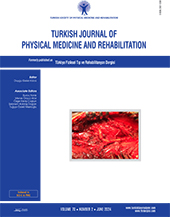Which aerobic exercise is more effective in Parkinson's patients? Cycle ergometer versus body weight-supported treadmill
2 Department of Cardiology, Trakya University Faculty of Medicine, Edirne, Türkiye
3 Department of Biostatistics, Trakya University Faculty of Medicine, Edirne, Türkiye
4 Department of Neurology, Trakya University Faculty of Medicine, Edirne, Türkiye DOI : 10.5606/tftrd.2024.11991 Objectives: The study aimed to evaluate the effects of aerobic exercise applied with bodyweight-supported treadmill (BWSTT) or cycle ergometer (CE) in Parkinson's patients.
Patients and methods: In the prospective single-blind study, 38 Parkinson's patients with Hoehn-Yahr Stage 1-3 were randomized into the CE and BWSTT groups between May 2019 and March 2020. Evaluations before and after six weeks of treatment included a six-min walking test with a software device as the primary outcome and functional balance tests (Tinetti balance and gait test, one-leg stance balance test) as secondary outcomes. Both groups received 40 min of aerobic exercise three days per week with conventional rehabilitation and various methods. CE and BWSTT groups were created. The aerobic exercise program was designed based on treatment recommendations for Parkinson's patients of the American College of Sports Medicine (CE test, with the Karvonen formula, 40-60% reserve). Posttreatment and pretreatment evaluations were compared within and between groups.
Results: The six-week aerobic exercise program was completed by 16 participants (9 males, 7 females; mean age: 65.9±8.1; range, 47 to 78 years) in the CE group and 15 participants (9 males, 6 females; mean age: 62.5±7.5; range, 49 to 79 years) in the BWSTT group. The demographic characteristics of the patients were similar. Primary and secondary outcomes were significantly different after treatment than before treatment in both groups. There were no significant differences between the groups in outcomes.
Conclusion: The results showed that both methods are effective and not superior to each other. Aerobic exercise programs led by experienced clinicians can benefit patients.
Anahtar Kelimeler : Cardiac rehabilitation, exercise therapy, Parkinson's disease

















